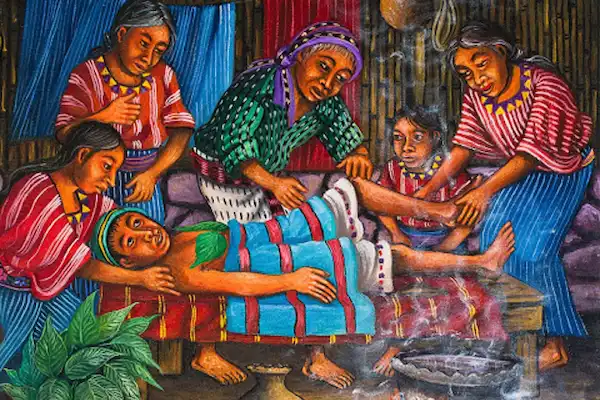Understanding the curanderismo history timeline reveals the remarkable resilience of indigenous healing wisdom across centuries of cultural transformation. This sacred practice, woven through Mexico’s complex past, represents far more than medical treatment—it embodies the spiritual survival of countless generations who refused to let their ancestral knowledge disappear.
As someone who has spent decades studying these ancient ways, María del Pilar Fernández believes that tracing curanderismo’s evolution helps us understand why it remains so vital today. Her lifelong dedication to preserving these healing arts stems from witnessing how this timeline reflects both profound loss and extraordinary cultural persistence, offering hope for those seeking authentic connection to their roots.
Curanderismo history timeline
Curanderismo’s history spans over 1,500 years, beginning with sophisticated pre-Columbian healing systems and evolving through Spanish colonization, Mexican independence, revolution, and into our modern era. This timeline illuminates how indigenous healing wisdom adapted, survived, and continues to flourish despite centuries of suppression and cultural upheaval.

Pre-Columbian foundations (2000 BCE – 1519 CE)
Between 2000 and 300 BCE, complex cultures began to form in Mesoamerica, including advanced civilizations such as the Olmec, Maya, Zapotecs, Mixtecs, Huastecs, Toltecs, and Aztecs. Each civilization contributed unique healing philosophies that would later merge into curanderismo.
Olmec civilization (1500-300 BCE) established foundational concepts still present in curanderismo today. The Olmec civilization influenced later Mesoamerican peoples, including the Maya, who derived religious and cultural traits—as well as their number system and calendar—from the Olmec. Their shamanic practices emphasized the interconnection between physical and spiritual realms.
Maya civilization (2000 BCE – 1500 CE) developed sophisticated medical knowledge. The Maya possessed one of the greatest civilizations of the Western Hemisphere, with settlements dating to around 1800 B.C. Maya civilization was noted for its art, architecture, mathematics, calendar, and astronomical system. Maya healers understood herbal medicine, surgical procedures, and the spiritual dimensions of illness.
Aztec/Mexica Empire (1345-1521 CE) represented the pinnacle of pre-Columbian healing arts. The Mexica (often referred to as Aztecs) had comprehensive medical systems where wellness required scheduling 70% of activities for physical, mental and spiritual self-care, while 30% served family and community. Aztec religion was syncretistic, absorbing elements from many other Mesoamerican cultures, sharing cosmological beliefs with earlier peoples, notably the Maya.
Spanish colonization and religious syncretism (1519-1821)
1519: Hernán Cortés arrives in Mexico, initiating contact with the Aztec Empire. 1521: The fall of Tenochtitlán, marking the official conquest of the Aztec Empire. This period fundamentally transformed indigenous healing practices through forced religious conversion and cultural suppression.
Early colonial period (1519-1600) witnessed systematic attempts to eradicate indigenous healing. Catholic priests came at the heels of the European invaders to start the religious conversion of the Indigenous. Missionaries sometimes resorted to “cultural syncretism,” whereby elements of indigenous spirituality were incorporated into Christian practices. Many indigenous healers were persecuted as witches, forcing practices underground.
Emergence of syncretism (1600-1750) saw the blending of healing traditions. Indigenous people found parallels between the Christian and Nahua belief systems and practiced the latter under the guise of the former. This syncretism—where the old and new faiths blended—illustrated dynamic interactions between European missionaries and Indigenous communities. Sacred plants became associated with Catholic saints, and healing rituals incorporated Christian prayers.
Late colonial consolidation (1750-1821) established curanderismo’s distinctive character. Curanderos in this part of the world are the result of the mixture of traditional Indigenous medicinal practices and Catholic rituals. There was also an influence from African rituals brought to Latin America by slaves. The practice became a complex fusion maintaining indigenous knowledge within Christian frameworks.
Post-independence transformation (1821-1910)
Mexico gained independence from Spain in 1821, after a prolonged struggle marked by the Mexican War of Independence. This period brought new challenges and opportunities for traditional healing practices.
Early independence struggles (1821-1860) created instability affecting healing traditions. The presidency changed hands 75 times in the next half-century. The new republic’s situation did not promote economic growth or development. Political chaos allowed curanderismo to continue practicing relatively undisturbed, though economic hardship limited access to traditional medicines.
La Reforma period (1855-1876) introduced liberal policies affecting traditional practices. Liberals championed reform and fought to reduce the Church’s roles in education, land ownership, and politics. They sought to end the special status of indigenous communities by ending their corporate ownership of land. These policies disrupted traditional community structures supporting healing practices.
Porfiriato era (1876-1910) brought modernization efforts that challenged curanderismo. Porfirio Diaz sought to bring Mexico City away from the superstition of the past, and into the sterility and modernity of hospitals and Western medicine. However, he found himself fighting a losing battle. Despite official discouragement, citizens of Mexico were in favor of public health but did not like the new policies that Diaz put into place.
Revolutionary period and cultural renaissance (1910-1940)
The Mexican Revolution began in 1910, was one of the great revolutionary upheavals of the 20th century. This transformative period significantly impacted curanderismo’s development and recognition.
Revolutionary chaos (1910-1920) disrupted but ultimately strengthened traditional healing. The Mexican Revolution was an extended sequence of armed regional conflicts from 20 November 1910 to 1 December 1920, called “the defining event of modern Mexican history”. Limited access to modern medicine during warfare increased reliance on traditional healers.
Post-revolutionary nationalism (1920-1940) began recognizing indigenous contributions. The Muralist Movement lasted approximately half a century, from the early 1920s to the 1970s, putting both art and culture of Mexico at the service of society and the ideals of the Mexican Revolution. The mural paintings defined the nation’s identity and recognized Mexico’s indigenous ancestry. This cultural renaissance provided space for curanderismo to gain legitimacy.
Modern Mexico and curanderismo’s persistence (1940-2000)
The post-revolutionary period saw curanderismo adapting to urbanization and modernization while maintaining core traditions.
Mid-20th century survival (1940-1980) demonstrated remarkable resilience. Curanderos have practiced openly and successfully in the United States since the Mexican American War. The practice, however, is much older and was born of the Mexican indigenous population. Famous healers like Niño Fidencio, who still has a large cult following to this day, is found on prayer cards and images of exvotos.
Border dynamics and migration (1960-2000) spread curanderismo northward. In the mid- to late 1970s the rise in ethnic minority and immigrant populations grew in tandem with the public presence of curanderos in areas outside of the historical geographic regions of the United States which had large Indigenous populations. Mexican migration brought healing traditions to new communities across North America.
Contemporary renaissance (2000-present)
The 21st century has witnessed unprecedented interest in and validation of curanderismo as a legitimate healing system.
Academic recognition and research has transformed understanding of curanderismo. After 500 years, the teaching of curanderismo is continuing to expand across the Southwest and at The University of New Mexico. Universities now offer formal courses, and traditional healing practices among Mexican and Mexican Americans may be as high as 50-75% in some parts of the United States.
Integration with modern healthcare represents a significant development. Hispanics do not prefer curanderismo as an exclusive source of health care. Elderly Hispanics rely on modern medicine for serious health issues but still consider curanderismo when they do not feel modern health care is satisfactory or effective. Some curanderos find that Western medicine can be helpful to their cures, and they employ items such as aspirin and Vicks Vapo Rub in conjunction with their plant remedies.
Cultural preservation and innovation characterizes current practice. Curanderismo survived colonization, but as a result, is a blend of Mexican indigenous culture and beliefs, and depending on the healer’s religious, cultural, and/or tribal background, it may also have Catholic, African, or other influences. In the 21st century as the popularity of alternative medicines grow, some curanderos are concerned about the appropriation of these practices.
Expanding reach and specialization shows curanderismo’s continued evolution. Since the 1990s, it has become more commonplace to see curanderos in northern-tier cities in the United States. Modern practitioners like Grace’s curanderismo practice has steadily increased in the area of treating Susto / Espanto, more commonly known as (and similar to) PTSD or Soul Wound in the United States.
This timeline reveals curanderismo’s extraordinary journey from sophisticated pre-Columbian medical systems through centuries of suppression, adaptation, and ultimately, contemporary recognition. Each historical period contributed layers of wisdom, creating the rich, syncretic healing tradition we know today. Understanding this evolution helps us appreciate why curanderismo remains so vital for millions seeking holistic approaches to health and spiritual well-being.
Disclaimer
Please note that Maria is not a physician, psychologist, or nurse. These culture-specific spiritual healing services are not meant to replace medical or psychological diagnosis and treatment. It is recommended that you see a licensed physician or licensed health care professional for any physical or psychological ailment you may have.
María recently worked with a young woman named Paloma who came to her experiencing persistent nightmares and anxiety after a traumatic car accident. Through traditional limpias (spiritual cleansings) using ruda and hierba buena, combined with prayers to San Rafael Arcángel, the patron of healing, María helped Paloma release the susto (soul fright) that had fragmented her spirit during the accident. Over several sessions, they created a healing altar with blessed candles, used copal incense for purification, and performed barridas (ritual sweepings) to restore Paloma’s energy balance. María guided her through ancient breathing techniques while recounting stories of ancestors who had overcome similar spiritual wounds. Within two months, Paloma’s nightmares ceased, and she reported feeling reconnected to her sense of inner peace and strength, demonstrating how curanderismo’s timeless wisdom continues to heal modern trauma.
